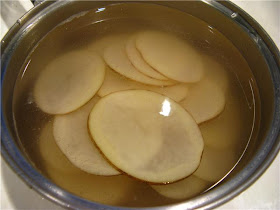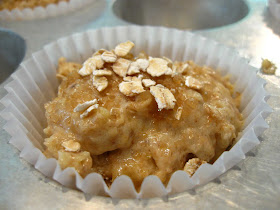
Tara’s mom here. Just thought I’d offer a blog post to a very overworked daughter. Besides, I received a new kitchen toy for Christmas and I’ve been having a great time with it and would love to share my biggest success so far. Have you ever used a mandoline? I never realized I needed one, and actually probably don’t, but if you want to make potato chips, it’s a necessity. I will eventually try other sliced veggie variations, but for now, potato chips have captured my attention.
I love potato chips, but they are way too calorific and salty for someone my age. (Don’t ask.) When you make your own – ‘from scratch’ as the blog title says – you can have them your way. The potato-y taste and crunchiness that comes from having absolutely no oil on these things is fantastic, and you can use only as much salt as you think you can tolerate…or not.
This mandoline is stainless steel, with an adjustable blade that will take your fingertip off, so you want to make sure to use the pusher and keep those fingers safe. It also has four other cutter inserts that make various-sized veggie strips from julienne to french fry. But you don’t need this fancy a mandoline; you just need one that can cut veggies into very thin, even slices so that they dry fairly evenly into crispy slices.
Now I’m not saying these are quick – they definitely are labor-intensive, and you can’t make a lot each go. But I’ve found that the more I make, the quicker I get at it, and I only have to watch closely during the last minute or so in the crisping process. For me, they’re worth it because I usually try to avoid store-bought potato chips; they’re just not that good for my health.
Guilt-free potato chips require two ingredients (russet potatoes and salt) and four basic steps.
1. Slice the potato with a mandoline. I start with one monster russet potato, the fatter and rounder the shape, the better. I’ve tried new potatoes, but the russets are bigger and they have better flavor. You might experiment with Yukon Gold or others too. I cut 1/16” slices on my mandoline, which produces very thin chips that crisp easily.

2. Soak the slices in cold water to remove excess starch. You could skip this step if you’re in a hurry, but I think the chips taste better and are crunchier if you soak them. Maybe that’s my imagination, but when you see the murky water that results when you soak the slices, somehow it just seems better to get that out! I‘ve tried both ways, and prefer soaking.

3. Sandwich the slices between two towels, paper or cloth, to dry; the drier they are, the faster they’ll crisp. After pressing them a bit, I uncover them and add whatever salt I want (for me, not a lot). This will pull out a bit more water, which you can daub off after a few minutes. Then you can let them dry a couple more minutes. But I often get impatient at this stage and put them right into the microwave.

4. Nuke the slices in a microwave oven. I cut a piece of parchment paper the diameter of my glass rotating tray and lay the slices in a circular pattern on that. Depending on the size of the slices, I can do maybe 20 to 30 slices at a time. Since they shrink as they dry, I sometimes overlap them a bit to cram more in, but they can stick together if you don’t separate them after the first five minutes. Microwave on high for five minutes. You will have to do some experimentation here because every microwave oven is different. Your times may be more or less than mine. The first five minutes releases a fair amount of water from the slices.
After the five minutes, I gently pull out the parchment with the slices on it onto the counter in front of the oven. I find if I mop up the water that collects on the glass tray beneath it, things go a bit faster. You will discover your own shortcuts as you keep at it, depending on your oven and patience.

You can either slide the paper with the slices back into the oven, pushing them around a bit to make sure they’re not sticking, or arrange them directly onto the glass tray. It goes somewhat faster without the wet paper. Also, my oven tends to cook the center ones faster, so since I’m rearranging slices anyway, I eliminate the parchment.

Now I turn the oven on for three minutes. If the slices are big and they haven’t started to crisp much in the first five minutes, I ignore them again for this time period. As you continue for one minute bursts, you’ll notice some are starting to get tan, then brown. I happen to like my chips a bit on the brown side, but some of you will consider that too done, so watch them and take them out when they suit your taste. You do need to get them crisp though. Put them on a paper towel, and they will crisp further as they cool. If I am going to store a bunch of these, I want to make sure they are all very dry, so as each batch comes out of the microwave, I put them onto a cookie sheet and hold them in my regular oven at only 150 degrees. That way, by the time I’m done with all the slices, I know every one of them is crisp and they won’t become soft in the storage bag.

These are great as appetizers with dips, and just for snacking. What more could you ask for? Fantastic guilt-free potato chips!
















